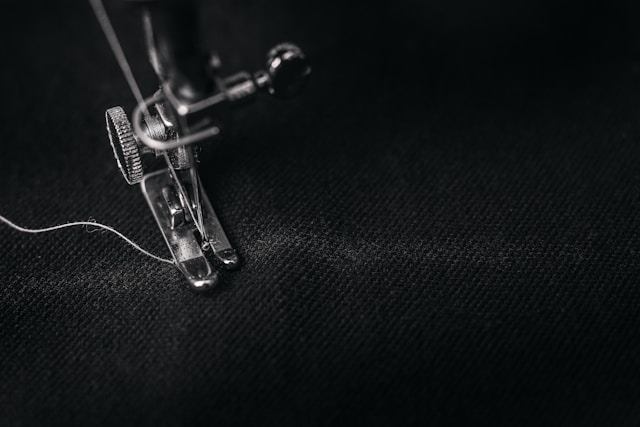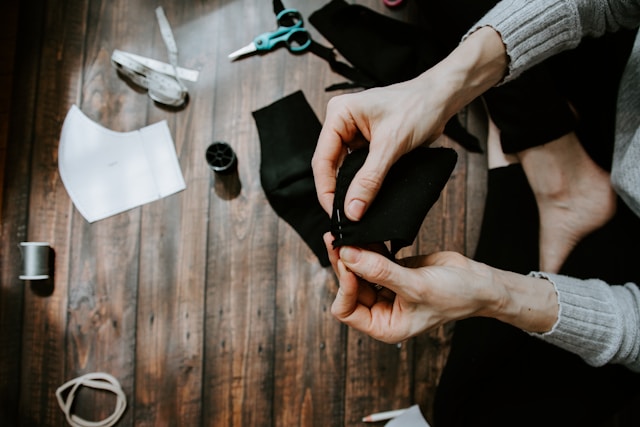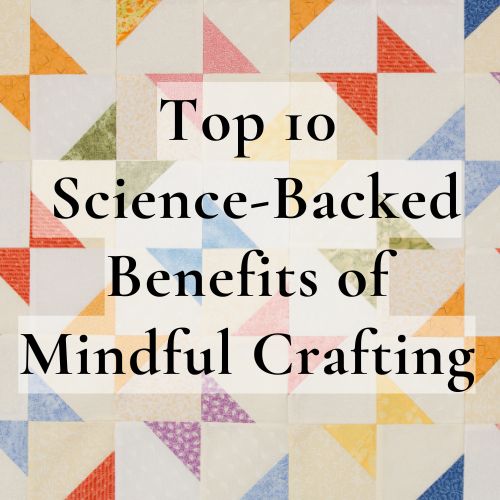Mindful crafting isn’t just a creative hobby—it’s a powerful tool for improving mental health, reducing stress, and boosting overall well-being. Whether you’re knitting, crocheting, quilting, or embroidering, engaging in mindful crafting activates key areas of the brain, helps regulate emotions, and enhances focus. Science is catching up with what crafters have known all along: making with your hands isn’t just relaxing—it’s transformative.
Top 10 Mindful Crafting Benefits
In this post, we’ll explore 10 science-backed benefits of mindful crafting, showing you exactly why creativity should be an essential part of your self-care routine.
1. Lowers Stress and Anxiety
Numerous studies show that engaging in repetitive, rhythmic hand movements (like knitting, sewing, or crocheting) activates the parasympathetic nervous system, which helps the body shift from a stress response (fight-or-flight) into a state of relaxation and recovery. This natural calming effect reduces stress and anxiety by lowering cortisol levels, the hormone responsible for chronic stress.
Beyond just easing mental tension, this shift toward relaxation also supports total wellness—reducing heart rate, lowering blood pressure, and even improving digestion and immune function. When practiced regularly, fiber arts can contribute to long-term emotional balance, helping to counteract the negative effects of chronic stress while promoting a deep sense of inner peace and well-being.
2. Enhances Focus and Concentration
Struggling with brain fog or distraction? Mindful crafting requires focused attention, helping strengthen neural pathways related to concentration. This can be especially beneficial for individuals with ADHD or those looking for ways to improve cognitive function.

3. Increases Dopamine and Serotonin
Crafting isn’t just enjoyable—it’s chemically rewarding. Engaging in creative activities releases dopamine, the “feel-good” neurotransmitter, which helps regulate mood and motivation. Additionally, the satisfaction of finishing a project boosts serotonin levels, which can improve overall mental well-being.
4. Creates a State of Flow (Like Meditation, But Easier!)
Ever lose track of time while crafting? That’s called flow, a psychological state where you’re fully immersed in an activity, so focused that everything else fades into the background. Flow is deeply beneficial for mental health because it allows you to experience complete presence, effortless engagement, and a sense of creative momentum.
✔ Reduces Stress and Anxiety – When you enter flow, your brain shifts into a relaxed, yet highly focused state, lowering cortisol levels and promoting calm.
✔ Enhances Creativity – Flow fosters uninterrupted creative thinking, allowing new ideas to emerge naturally without self-doubt or overthinking.
✔ Improves Mood and Well-Being – The deep engagement of flow triggers the release of dopamine, the brain’s feel-good chemical, which boosts motivation and happiness.
✔ Increases Focus and Concentration – Flow strengthens neural pathways related to attention and cognitive function, making it easier to stay engaged in tasks beyond crafting.
✔ Creates a Meditative Experience Without Stillness – Unlike traditional meditation, which can feel difficult for restless minds, crafting in a flow state provides similar mindfulness benefits without requiring stillness or silence.
By embracing flow through fiber arts, you can achieve a sense of deep relaxation and heightened creativity—all while making something beautiful with your hands.
5. Reduces Symptoms of Depression
Research suggests that engaging in creative activities can be a natural antidepressant by stimulating areas of the brain associated with pleasure and reward. The sense of accomplishment and joy from creating something with your hands can be a powerful tool for combating feelings of sadness or depression.
My own experience backs this up. I’ve written about that extensively in my book Crochet Saved My Life and widely around the web as well. When I first started writing about it, it didn’t seem like anyone was talking about the benefits of crochet. In the decade plus since, there’s been much more research and anecdotal evidence supporting this. And I’m glad to see it!

6. Improves Fine Motor Skills and Brain Function
Mindful crafting isn’t just good for the mind—it’s great for the body, too. Knitting, crocheting, embroidery, and quilting all involve intricate hand movements that improve fine motor skills, coordination, and even cognitive agility, helping to keep the brain sharp as we age.
7. Boosts Self-Esteem and Confidence
Completing a project-no matter how big or small—creates a tangible sense of accomplishment, reinforcing your ability to set goals, follow through, and bring something to life with your own hands. This feeling of success is more than just satisfaction—it’s a powerful confidence booster that carries over into other areas of life.
✔ Builds Self-Trust – Every finished project is proof that you can start something and see it through, strengthening trust in your own persistence and abilities.
✔ Shows Visible Growth – Looking back at past projects allows you to see measurable progress in your skills, creativity, and techniques, reminding you of how far you’ve come.
✔ Encourages Problem-Solving – Many projects come with challenges—mistakes, miscalculations, or unexpected setbacks. Overcoming these moments builds resilience and adaptability, reinforcing the idea that you can handle obstacles.
✔ Fosters a Sense of Creative Identity – The more projects you complete, the more you recognize your unique creative voice and style, reinforcing the belief that your artistic expression is valuable.
✔ Increases Motivation for Future Projects – Success fuels momentum. Each completed piece builds confidence for tackling more complex, ambitious projects, proving that your creativity has no limits.
Over time, seeing your own progress through crafting shifts the way you see yourself—from someone who dabbles in creativity to someone who is capable, skilled, and truly an artist in their own right.
8. Helps With Emotional Processing
For many, crafting is a form of emotional release. The act of creating can help process grief, anxiety, or difficult emotions, providing a non-verbal outlet for feelings that may be hard to express in words.
9. Strengthens Social Connection
While crafting can be a deeply personal and solitary activity, it also has a powerful social dimension that fosters connection and community. Engaging in a shared craft—whether through a quilting bee, a knitting circle, or an embroidery club—creates an environment where creativity and conversation flow naturally. These spaces offer more than just technical skill-sharing; they become places of support, laughter, and companionship, where makers can exchange ideas, celebrate progress, and encourage one another. The simple act of sitting together, stitching, knitting, or weaving, provides a sense of shared purpose, reinforcing the idea that creativity thrives in connection.
Beyond the joy of shared creativity, crafting communities provide essential mental health benefits. Studies show that social interaction reduces feelings of loneliness, increases feelings of belonging, and even lowers stress levels. In craft groups, there’s an unspoken understanding that the process matters just as much as the final product—creating a judgment-free space where individuals can express themselves freely. Many people find that talking while working with their hands allows for deeper, more natural conversations, making it easier to share thoughts, process emotions, and feel supported. Whether in-person or virtual, these creative communities offer something invaluable: a reminder that we are never truly alone in our craft or in our lives.
10. Encourages Mindfulness and Presence
Perhaps the biggest benefit of mindful crafting is that it naturally brings you into the present moment. Instead of worrying about the past or future, your focus is on each stitch, loop, or thread, helping you cultivate a greater sense of mindfulness and peace. Mindful crafting offers, well, mindfulness.

Next Steps: How to Use Mindful Crafting to Heal
Now that you know the science-backed benefits of mindful crafting, how can you incorporate it into your life more intentionally?
✔ Set aside time for daily or weekly crafting sessions. Even 10–15 minutes of mindful stitching can have a positive effect.
✔ Turn crafting into a self-care ritual. Pair it with a cup of tea, soothing music, or deep breathing for an added layer of relaxation.
✔ Try new techniques that encourage mindfulness. Slow stitching, freehand embroidery, or repetitive crochet patterns can deepen the meditative aspect of making.
✔ Join a creative community. Connecting with others who craft can provide motivation, inspiration, and support.
If you’re looking for ways to explore mindful crafting as a tool for emotional well-being, the Craft to Heal year-long workshop series is designed for you. Each month, we’ll explore different aspects of creativity and healing through fiber arts, helping you build a deeper, more intentional crafting practice.
Click here to learn more about the Craft to Heal Workshop Series.
